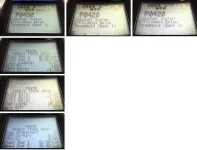Agree with Zora -
Here's the code detail:
DTC Code: P0420
Description: Catalyst System Efficiency Below Threshold Bank 1
Probable Causes:
- Sensor or solenoid faulty
- Connector terminal contact is damaged or corroded
- Wire harness - Check harness for correct voltage, open, short to ground or short to voltage
- Update control unit software - Check for the latest control unit update
- Powertrain or Engine Control Module faulty
- HO2S sensor contamination/damaged
- Exhaust leaks or restrictions
- Catalytic converter damage
- Catalytic converter improper operation
My first thoughts were catalytic converter, vacuum leak, bad HO2 sensor(s). The codes that were set are both the same - one is for Bank 1 and the other Bank 2 for the exhaust. Because this happened on both banks I would rule out the HO2 sensors because I would doubt that you would have multiple failures on the sensors at the same time.
Do you have a OBD II scanner or have access to one?
If so you could check the function of the HO2 sensors.
Another check for the CAT is to use a infrared thermometer on both CATs to make sure they're getting up to temp - IIRC they should operate in the 1200-1600 F range - they start working at about 600 F and at 2000 F they start to have problems. So, temps below or above the ideal range could indicate a problem inside the cat. If the CATs are operating at the right temp then that should rule them out.
You could also pull your NEG battery cable for 15 mins and let the codes get deleted and then run it again and see if they get set again.
Since you say it happened after you forgot to replace the gas cap I'm thinking that it might have just gotten a bad vacuum reading and either it still has a vac problem or the codes just need to be reset.
After you do some checks let us know what you find and that will help narrow it down - good luck.
ADD:
Here's a decent link to CAT failures -
http://auto.howstuffworks.com/question482.htm
And a really good video on CAT diagnosis -
http://www.youtube.com/watch?v=9VZ5K8n5jj0

